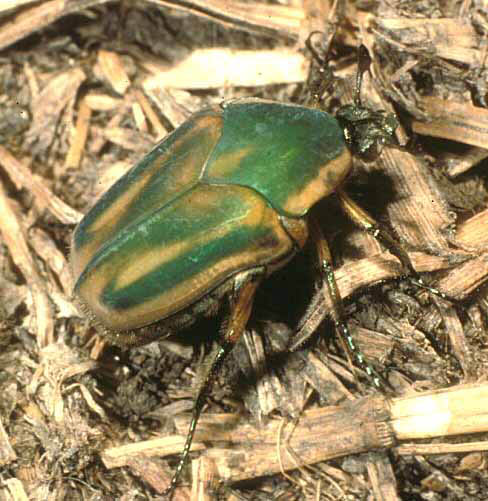Issue 12, July 17, 2009
Scouting Watch
Bagworms are treatable at this time. Heavy populations have been reported from southern and central Illinois locations. Numbers tend to be low in northern Illinois, particularly in northeastern Illinois. Be sure to scout for caterpillars before treating, particularly in the northern two-thirds of the state where cold winter temperatures apparently caused local population crashes.
Green June Beetles are very numerous in the southern two-thirds of the state. Large numbers are being reported flying across turf. Green June beetle adults are about one inch long, heavy-bodied, and green with indistinct yellow stripes along the sides. They fly with a loud buzzing sound during sunny times of the day. They appear to seek out upright objects, including people, to fly into. There is no control for the adults. The larvae are a white grub that feeds on dead grass, so they are not a primary pest of turfgrass. However, they will feed on the dead grass in turf, and in the process, loosen the roots of live turf, causing dieback.

 Emerald Ash Borer parasitic wasps are being released in Evanston and Chicago, both in Cook County. Oobius agrili lays eggs into emerald ash borer eggs. The parasitoid larva feeds on the borer egg contents, killing the egg. The adult wasp is tiny, being about one-half the size of the head of a straight pin. Being so small, it is unable to sting humans. In China, this insect reduces emerald ash borer numbers 50-60%. It was released last year in Michigan and has survived in that climate. It is too early to determine how effective it will be in controlling emerald ash borer in the U.S. This parasitic wasp was tested on many North American insects before release, and was found to be very specific to emerald ash borer.--Phil Nixon, Fredric Miller, Hank Wilkinson
Emerald Ash Borer parasitic wasps are being released in Evanston and Chicago, both in Cook County. Oobius agrili lays eggs into emerald ash borer eggs. The parasitoid larva feeds on the borer egg contents, killing the egg. The adult wasp is tiny, being about one-half the size of the head of a straight pin. Being so small, it is unable to sting humans. In China, this insect reduces emerald ash borer numbers 50-60%. It was released last year in Michigan and has survived in that climate. It is too early to determine how effective it will be in controlling emerald ash borer in the U.S. This parasitic wasp was tested on many North American insects before release, and was found to be very specific to emerald ash borer.--Phil Nixon, Fredric Miller, Hank Wilkinson
Author:
Phil Nixon